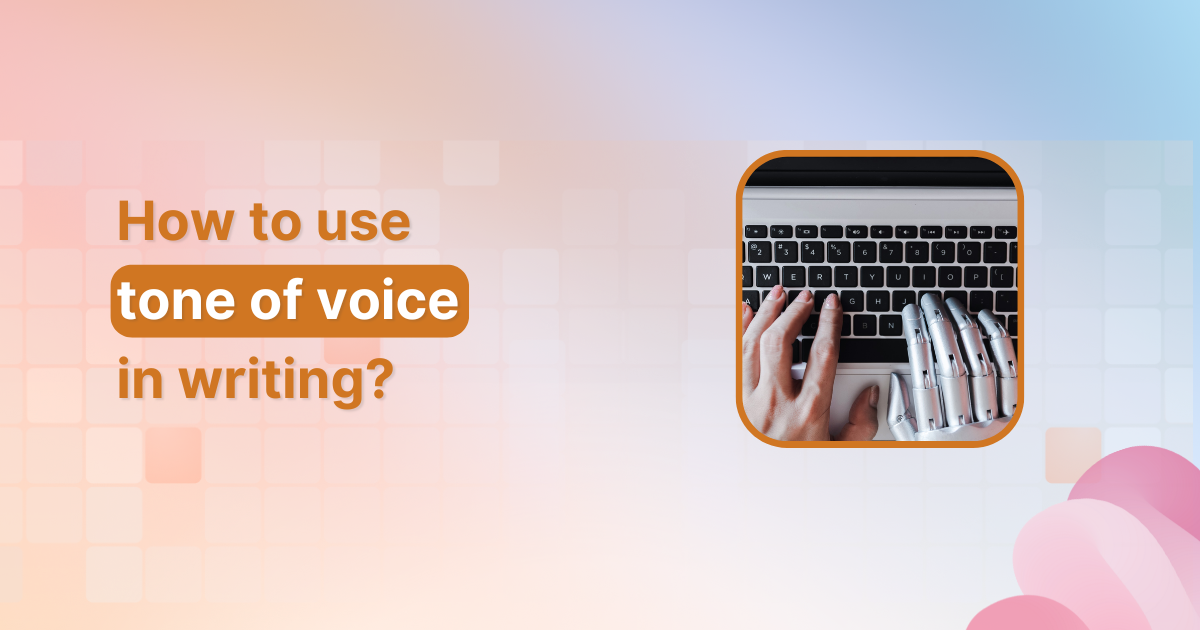How to use tone of voice in writing?

Ever read something that felt cold and robotic,
when it should’ve been warm and engaging?
Or maybe a message that sounded too casual when it needed authority?
That’s where tone of voice comes in – it shapes how your words connect with readers. Whether you’re crafting blog posts, sales copy, or emails, getting the right tone is crucial.
With tools like Contentpen’s AI blog writer, you don’t have to guess. This powerful tool helps you adjust your writing tone effortlessly, ensuring your content sounds exactly how you want – professional, friendly, persuasive, or anything in between.
In this guide, we’ll explore how to use tone effectively and how Contentpen makes it easier than ever.
What is tone of voice in writing?
Tone of voice in writing refers to the way your words express emotions, personality, and intent. It’s how your content “sounds” to the reader – whether formal, casual, enthusiastic, or authoritative.
Different types of tone of voice in writing with examples
The tone of voice in writing defines how your message is perceived. It influences emotions, engagement, and brand identity.
Here are some common types of tones, along with examples:
1. Formal tone
Used in professional, academic, or business settings where clarity and respect are essential.
Example:
“We appreciate your inquiry and will review your request shortly. Please expect a response within 24 hours.”
2. Informal tone
Conversational, friendly, and relaxed – often used in blogs, social media, or casual emails.
Example:
“Hey there! Just letting you know we got your request. We’ll get back to you ASAP!”
3. Persuasive tone
Encourages action, often seen in marketing, sales, or opinion pieces.
Example:
“Don’t miss out on this exclusive deal – sign up today and save 30%!”
4. Authoritative tone
Establishes credibility and expertise, commonly used in thought leadership and industry-specific content.
Example:
“Based on extensive research, our latest report outlines the key strategies for business growth in 2024.”
5. Empathetic tone
Shows understanding and compassion, often used in customer support, healthcare, or sensitive communications.
Example:
“We understand that delays can be frustrating. Our team is actively working to resolve the issue, and we appreciate your patience.”
6. Humorous tone
Lighthearted and entertaining, used to engage audiences and make content more relatable.
Example:
“Mondays are tough, but at least there’s coffee. And if that’s not enough, we’ve got a 20% discount to brighten your day!”
7. Inspirational tone
Encourages and motivates, commonly seen in personal development, fitness, or leadership content.
Example:
“Your dreams are within reach – take the first step today, and success will follow!”
8. Storytelling tone
Engages readers through narratives and experiences, often used in branding and content marketing.
Example:
“Five years ago, we started in a small garage with one vision – to revolutionize the way businesses grow online. Today, we’re helping thousands achieve that goal.”
9. Sarcastic/Ironic tone
Adds humor with a playful or exaggerated twist, often used for entertainment or social media.
Example:
“Oh great, another Monday! Just what we needed – more emails and less sleep.”
10. Urgent tone
Creates a sense of immediacy to drive action, often used in sales and promotions.
Example:
“Only a few hours left! Grab your deal before it’s gone forever!”
How to control and adapt your tone easily?
Maintaining a consistent brand voice in writing is key to building trust. Fortunately, with advancements in AI technology, managing your brand voice has never been easier.
One of the most effective ways to achieve this is using an AI-powered writing assistant like Contentpen.
Meet Contentpen – Your AI-powered writing assistant
Brand voice generators, such as Contentpen, take the stress out of content automation, helping you automate, simplify, and scale your workflow effortlessly. With AI-driven precision, your brand voice stays consistent while you focus on crafting impactful blogs.
Upon setting up a workspace, a powerful AI agent meticulously studies your website, grasping everything from your brand identity and key differentiators to your audience and competition. You can also supplement its learning by providing PDFs, help guides, or additional reference materials.

What can Contentpen do for you?
Optimized blog outlines
- Research-backed structure for better readability
- Semantic SEO approach for strong on-page optimization
High-quality first drafts
- Multiple AI agents working in sync for precision
- Blends brand research with engaging storytelling
Seamless quality review & publishing
- AI-powered optimization for tone, clarity, and impact
- Direct publishing to WordPress and other CMS platforms

Keyword & title optimization
- AI-powered title suggestions to boost CTR
- Aligns with search intent for better rankings
- Keyword clustering for a strategic content plan
Deep research & SERP analysis
- Advanced AI bot for competitive analysis
- Identifies content gaps to help you rank higher
Besides that, Contentpen can add relevant images, videos, and internal and external links to make your blog posts more engaging and informative.
Learn more: How to write an article using Contentpen?
05 tips for controlling the tone of voice effectively
Here are five essential tips to help you refine your tone and ensure it aligns with your intended communication style.
1. Choose the right words
The words you choose greatly influence the tone of your writing. In informal settings, swapping complex jargon for simpler words makes your content more approachable and easier to understand.
When writing persuasively, using powerful verbs can strengthen your message and make it more compelling. In professional or technical writing, keeping terminology precise ensures clarity and maintains credibility.
2. Adjust sentence structure
Sentence structure impacts how your message is perceived. Short, direct sentences create a sense of urgency and make information more digestible.
In contrast, longer and more descriptive sentences are ideal for storytelling or formal writing, as they provide depth and context while maintaining a sophisticated tone.
3. Mind the punctuation
Punctuation adds subtle cues that shape the tone of your writing. Exclamation marks (!) convey excitement or enthusiasm, making statements feel more lively. Ellipses (…) can introduce suspense or a casual, conversational tone.
Meanwhile, periods (.) maintain a neutral or professional tone, ensuring clarity and formality where needed. Choosing the right punctuation helps set the mood and intent of your message.
4. Adapt based on medium
The medium you’re writing for also affects tone. Emails, blog posts, and social media content each require a different approach.
An email to a colleague may be professional yet friendly, while a blog post can be conversational and informative. Understanding the expectations of different platforms helps you adjust your tone accordingly.
5. Read aloud & edit
Reading your content aloud is a simple yet effective way to fine-tune your tone. It helps you catch inconsistencies, awkward phrasing, or unintended shifts in mood.
Once you’ve identified areas for improvement, careful editing ensures your tone aligns with your intended audience and purpose, making your message clearer and more impactful.
Final thoughts
Getting the tone of voice right isn’t just about sounding good – it’s about making real connections with your audience. Whether you’re writing a blog, sales pitch, or social post, the way your words “feel” can make all the difference.
By choosing the right words, structuring sentences effectively, and using tools brand voice generators like Contentpen, you can refine your tone and write blogs effortlessly.
So, instead of second-guessing, let AI help you craft messages that are clear, engaging, and true to your brand voice.
FAQs on tone of voice
To identify the right tone, consider your audience, purpose, and platform. Match formality to the context, ensuring clarity, engagement, and consistency.Add image
Define your tone beforehand and stick to a structured style. Regular editing and reading aloud help ensure consistency.
Avoid sudden shifts in tone, excessive formality or informality, and overuse of punctuation. Always align tone with audience and purpose.
AI-powered writing assistants, such as Contentpen, are designed to streamline the content creation process while ensuring your brand voice remains consistent across all platforms.
Your brand voice tone is important because it helps you build connections, strengthens brand identity, enhances clarity, and drives action.
You might be interested in...

The complete B2B content marketing guide: Strategy, funnel & examples
B2B content marketing is something that can make or break your business. You might already be familiar with its basics, but it is important to discuss it in detail in terms of types, benefits, examples, and strategies to implement a successful B2B content marketing strategy. And if you are wondering why you need B2B content […]
Oct 29, 2025

Content marketing examples that drive results in 2025
Here’s a sobering truth: 96% of content published online gets zero traffic from Google. Zero! Yet the examples you’re about to see generated millions of views, thousands of shares, and drove real business results. What makes them different? They didn’t follow the “publish and pray” strategy! Instead, each one used a specific psychological trigger, solved […]
Sep 29, 2025

What is blogging? The ultimate guide
Should I start my own blog? Is blogging dead? Can I get paid for blogging? What does blogging even mean in this age of AI? These are some of the most common questions associated with blogging, and we’ll be answering all of them in detail to understand what blogging is. Blogging has changed a lot […]
Sep 17, 2025